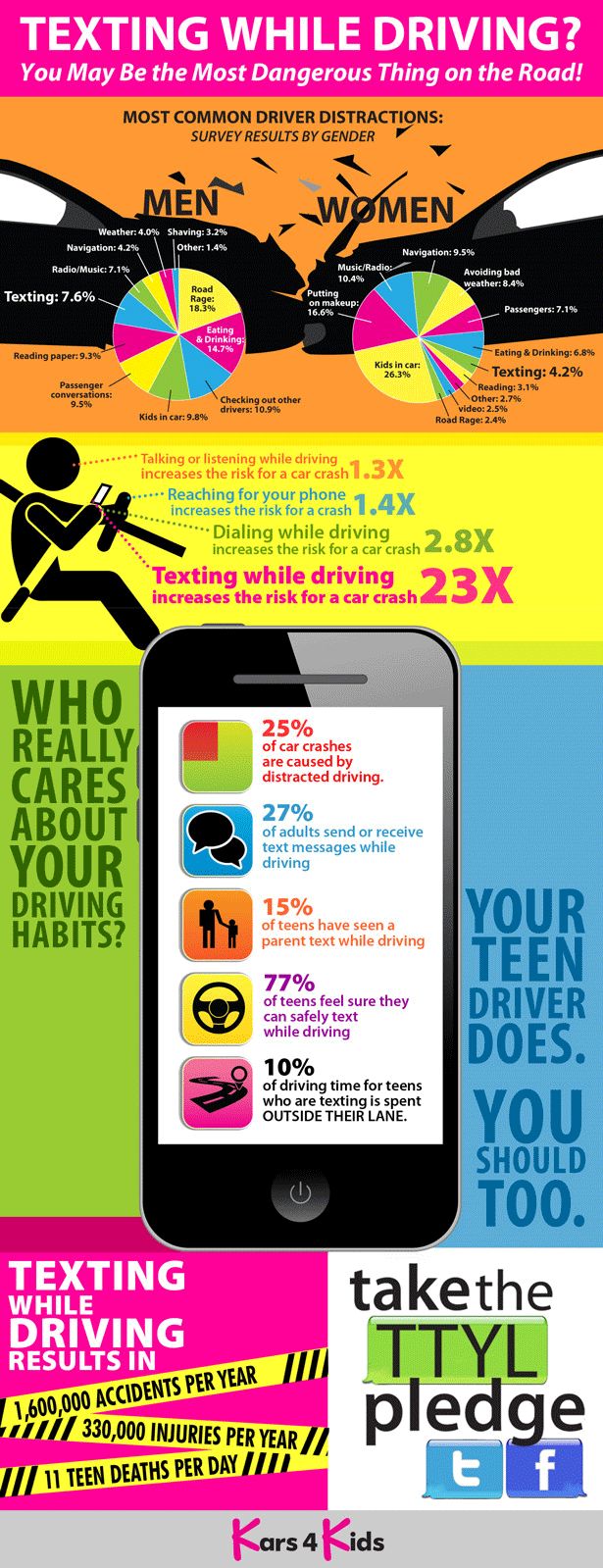Once upon a time, we worried about teens driving while under the influence of alcohol. We still worry about that every time our kids step out the door to go to a party, but now we've got a new and more pervasive danger to worry about and it's the direct result of our technologically advanced times. The new danger is texting while driving, something teens can't seem to resist.
Texting while driving falls under the umbrella of "distracted driving," which is anything you do at the same time as driving. Distracted driving could involve something seemingly innocuous that shifts your focus from your driving momentarily, like changing radio stations or picking up your travel cup to take a sip of coffee. The problem is that car crashes happen in just seconds. That seemingly innocuous sip of coffee can take lives on the road.
There are three basic types of driving distractions:
- Visual- - takes your eyes off the road
- Manual -- takes your hands off the wheel
- Cognitive-- takes your mind off your driving
Cuppa Joe
Picking up your travel cup for a sip of coffee is mostly about taking your hands off the wheel. It's a manual distraction. Texting while driving, on the other hand requires all three types of distractions.
There's the need to compose a mental message (cognitive), look at your phone screen (visual) and type a message (manual). All told, the act of texting while driving is a triple whammy of driving distraction.
We can understand how even a driving aid in the form of a talking GPS system might serve as a cognitive distraction that could divert your thoughts from your driving. Road rage, too, would be very absorbing in its various forms and could present a serious distraction while driving. The thing about texting, however, is that in addition to utilizing eyes, hands and mind, it has become such a common fact of life for teens that they fail to see the dangers posed by texting while driving.
Texting for teens is as natural an act as breathing. A teen may send and receive hundreds of texts each day. Texting is such a usual part of a teen's everyday routines that he or she may feel as though a precedent has been set, and may be lulled into thinking that texting while driving is normal (read: "safe").
Drinking Vs. Texting
What these young drivers may not know is that teen phone use during driving is known to increase the risk for accidents, while texting and driving raises the risk of a car crash by 23 times. Meantime, car accidents are the leading cause of teen deaths. Put into perspective the Centers for Disease Control and Prevention (CDC), reports that one in every ten high school teens drinks and drives. But nearly 43% of high school students who drive reported texting while driving within the past 30 days. This is according to a survey taken in 2011 and presented at the May 4, 2013 annual meeting of the Pediatric Academic Societies (PAS), in Washington, D.C.
Teen texting and driving has become so pervasive a problem that U.S. Transportation Secretary Ray LaHood has referred to the phenomenon as a "national epidemic."
Those teens who reported texting while driving were also more likely to take part in other risky behaviors, for instance drinking, thus raising the danger level even further. But passing state laws to ban texting while driving appears to have little effect: of those states that passed laws making texting and driving illegal, 39% of teens continued the practice, while 44% of teens in states without such restrictions engaged in texting while driving. The difference is not considered statistically significant.

Parents Can Help
While state laws don't appear to make a difference, caring parents can, according to the CDC. Teens may not seem to be listening to parents, but when asked whose opinion they count most, teens overwhelmingly name their parents. For this reason, experts believe that parents can help guide their children in making appropriate choices about driving safety and prevent or reduce the risk for teen car accidents.
Parents can take proactive steps in reducing the risks to their children by:
- Letting their teen children know they care about them
- Making a point to talk to teens about driving dangers
- Continuing to revisit the discussion over time
- Set rules, for example, no texting while driving
- Create and enforce a teen driving contract
It may not look like it, but your teen is listening to you and that just may save her life.
At Kars4Kids, we're taking texting while driving seriously. We're looking for ways to reach out to parents and their children of driving age about this dangerous trend. To that end, we've created a resource for parents and teens alike with our help fight texting while driving campaign. Take our TTYL pledge and share about it with your friends.